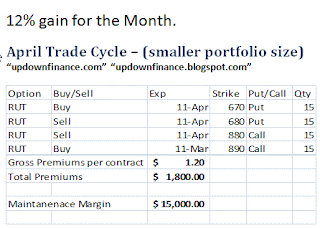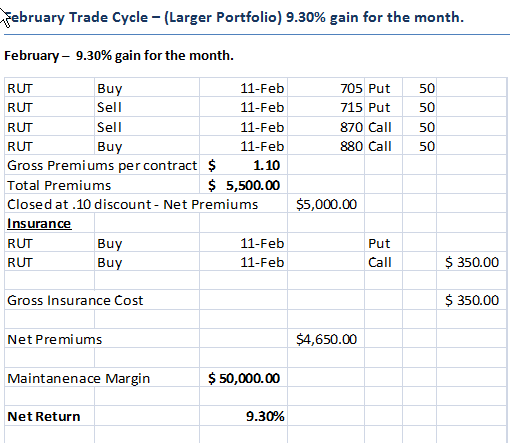Sunday, May 8, 2011
Monday, April 25, 2011
Six Months Returns
Friday, April 22, 2011
Working Your Order – The art of order execution.
Friday, April 15, 2011
Sunday, March 20, 2011
Friday, March 11, 2011
April Cycle Trade Alert (Last free Trade) and Move to "updownfinance.com"
Small Portfolio
Large Portfolio
Friday, February 25, 2011
Saturday, February 19, 2011
Friday, February 11, 2011
Trade Alert
Monday, February 7, 2011
Close 705/715 Put Spread for .05 or less
Close 870/880 call credit spread for .05 or less
Wednesday, February 2, 2011
Please send us your feedback and comments to -" updownfinance@gmail.com"
We started this blog with one purpose in mind, to make it a very good product that provides consistent positive investment returns to its members and one that meets their needs in terms of the quality of service we provide.
So far we have heard from quite a good number of members who have different suggestions. Some members wanted more frequent updates, others also wanted us to remove outdated trade alerts and the list goes on. Please be rest assured that we are taking all that into considerations and also asking those who haven't sent in their suggestions or comments to do so.
As some of you are aware, we will be limiting the number of subscribers, when we transition to a pay per subscriber model. This decision is to enable the subscriber base to get the most benefit and to ensure that our trades are not crowded, since these are income trades and mostly single trades, although we are planning on including other indexes like the SPX. So for the moment, we might end up having a waiting list but will do everything we can to ensure that the waiting list is managed on a first come first serve basis.
Once again thanks for your support and please write to us at - updownfinance@gmail.com.
Best Regards,
UpDownFinance Team
Tuesday, February 1, 2011
Trade Alert
Monday, January 31, 2011
Sunday, January 30, 2011
Basics of Credit Spreads and Iron Condors
Strike price difference is $5, i.e., $20 - $15 = $5
Technically no matter what happens to this trade the investor cannot lose more than $3000.
A call credit spread established at the top of the prevailing price of the instrument of choice is called a Bear Call Spread because we do not want the stock or index to breach the short (sold) call of the spread, i.e. in this example, we do not want the stock to go above $15 - the strike price of our sold calls. The Put credit spread established at the lower price range of the prevailing price is called a Bull Put spread, so named because the desired outcome is that the stock or index of choice does not fall to the point where it breaches the short put of the spread.
Bear Call Spread
Sell RUT Jan 11 840 Call Quantity 55
Bull Put Spread
Sell RUT Jan 11 685 Put Quantity 55
The RUT index at the time of setup had a price of 770. This gives us a range of 70 points to the upside and 85 points to the downside before either short strike prices to be breached.
Gross premiums per contract is $1.20
Maintenance Margin
If your broker requires maintenance margin on both sides of the spread this will result in twice the amount required in this case $110,000, which will tie up significant amounts of capital and reduce your return by half form 12% to 6%.
Wednesday, January 26, 2011
Watch For Trade Alert Today
So please stay tuned and watch for a trade alert in case we get a big up swing in the market.
Tuesday, January 25, 2011
Moving to a paid subscription Model - Please email your interest to updownfinance@gmail.com
"updownfinance@gmail.com"
We are also working on a multi platform alert system for the subscription as well.
Thanks for your support.
Friday, January 21, 2011
February trade cycle - Trade Alert
Thursday, January 20, 2011
February trade cycle Update
For larger portfolio buy 5 contracts.
Rule buy 1 contract for every 10 contracts you have.
Monday, January 17, 2011
Saturday, January 15, 2011
Friday, January 7, 2011
Wednesday, January 5, 2011
Portfolio set-up and adjustments
The income trader strategy is based on taking in premium (credits) and then relying on time (theta decay) to work for us. As indicated in one our postings, we set up positions approximately one week before the expiration of the current option cycle. The positions are set up based on our analysis of the Greeks; specifically we look to sell at a delta o f.08 for both the call and the put sides of the trade. To be successful at this strategy, you need a platform which will enable you see the delta's of the positions that you intend to put up.
The following is a summary of the thought process that we follow in setting and adjusting our trades.
1. Our preferred instrument of choice is the RUT Index.
2. Trades are set up one week before the expiration of the current option cycle.
3. For our short options, we look to sell at a delta of .08 for a credit of not less than $1. Depending on the volatility of the market, we may get a lower credit but we prefer a credit greater than $1.
4. When we sell at a delta of .08, on a normal distribution curve, this gives us a confidence interval of approximately 84%. This means that, there is an 84% (100% - 2*8) probability of success in the trade.
5. For all positions that we put up, we tend to buy some insurance against the trade going bad. For every 10 contracts, we will at least buy 1 or 2 contracts for protection.
6. As the trade evolves and time decay sets in, the delta of the short positions will change. We will always adjust our trades, when our short delta moves from .08 to .21. As soon as our short delta gets to .21, for risk management purposes, we will roll our short positions to a lower delta, preferably back to a delta of .08. We may intend increase our contracts (but not more than half of what we already have on) to help pay for some of the roll.
7. We will close our trades when we can get out of the position for a debit of 10 cents. There is no need to be greedy.
This is not a mechanical process but we follow laid down rules to enable us have capital to trade another day. You will appreciate the process better when you follow our trades.





















